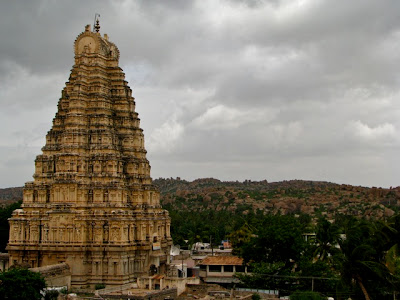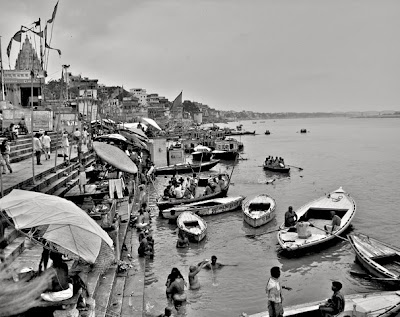
Friday, August 28, 2009
Thursday, August 27, 2009
Wednesday, August 26, 2009
Onion Domes

Tuesday, August 25, 2009
Hampi: Garuda's Chariot





Thursday, August 20, 2009
Wednesday, August 19, 2009
Hampi: The Virupaksha Gopura


Tuesday, August 18, 2009
Discussing this freedom
The Times of India on 15th August had an interview with M.F. Husain that talked about his recollections of 1947, independence, partition, his art and even ironically his own banishment from the country a few years ago following the brouhaha over his decades old painting of a naked Saraswati.
Over dinner later that evening this topic came up and I remarked how tragic it was that such a remarkable artist wasn't able to enter the country because of fear of arrest. Perhaps not surprisingly, I was told “Well yes, maybe, but he shouldn't have painted that.” “Why not? It was decades ago and it's hardly obscene.” At this point of course, the tired old rebuttal the one that I have heard time and time again was brought out – We keep tolerating such pictures. Why doesn't he paint Muhammad? The rules of Islam must be followed, but Hindu deities defiled?
Of course there are people who think this whole business is retarded, but they seem to me to be so small a minority as to be wholly invisible. Many of those who do agree that the situation is unfortunate, will often come out and say – but he shouldn't have painted that. The other more belligerent sort, of course, totally agree with the situation – would he ever dare to paint Muhammad naked?
Such spurious and ridiculous reasoning is most frustrating to say the least. For one those who do make these arguments refuse to reason. And they only helps illustrate how narrow, uninformed and chauvinistic a view they have of the religion they are seemingly protecting.
“It's not unusual or shocking to have a Hindu deity depicted nude,” I said, “So what is the big fuss? That a Muslim drew it?” “That's not the point. The thing is Hinduism has always been too liberal and that has only led to people further mocking and taking liberties with our idols. A stop has to be put somewhere. Do you think it's okay to have Lakshmi on your earrings1 or slippers? Our idols will be commodified and abused like the Buddha and the Buddhists have never really had the strength to bother to object. On the other hand, look at the ruckus that was created after the Danish cartoon incident.”2
Excellent. So the solution is to become more fanatical, less “effeminate”. These arguments, based on such fallacious logic, are so troubling because it is almost a matter of pride now, seemingly, to become more violent and belligerent. I have always felt that Hinduism is wonderful in how it encompasses so many varied, often completely non mainstream traditions, never defining apostasy. A large reason, I guess, is that rather than being a religion dictated by a strict rule book or code, it was a collection of beliefs – of all those peoples who lived beyond the Sindh; the Hindus. The shaping of the religion as we view it today is still largely influenced by the British understanding and interpretation – their very definition of the religion. Perhaps then, it's just reaching the logical puritanical end now.
Indian art has always drawn from Hindu myths – fantastical, beautiful, sexual. And it's not only Khajarao that has erotic statues, almost every temple does – the voluptuous skimpily clad apsaras and goddesses are everywhere. Should these be covered up too – perhaps like the statues at the Vatican, with leaves? It's also terribly silly to equate Hindu and Islamic artistic traditions – they have their own styles and stories that have found representation. But the ignorance of Islamic art is striking. For one, this false notion of Muhammad having never being painted is really untrue3. He has. Miniatures, across Turkey, Iran and India, have often represented the most wondrous, often erotic of stories – Leyla Majnun, Shirin Khusrau, of unknown meeting lovers.4
About a year ago, I was attending a talk on Islamic Art at the Asian Civilization Museum in Singapore. The professor talked about the kind of contemporary Islamic art he had seen in recent year – of course, mostly ignored by the international media, but much talked about in the local news. He mentioned an Islamic scholar in Indonesia who had exhibited some controversial paintings recently including one of a veiled Muhammad surrounded by semi naked houris. There had been no protests – perhaps it was just as well that these shows got little attention outside the local media.
The moral outrage people feel on behalf of a religion continues to baffle me. In the case of Husain, I just find it ironic that people have taken the mantle of protecting religious idols against a man who probably knows more about Hindu scriptures and tales than these moral guardians could ever hope to. And yet its their voice that is always the loudest, their refusal to listen to the other side rock solid, their ignorance complete. Depressingly, these people are the ones who seem to always manage to get their way.
1I don't care either way. But really, to say Hinduism isn't commodified enough already is laugh worthy.
2Talking of the Danish Cartoon incident, the Yale University Press took an amazingly tragic decision to not publish those cartoons in the forthcoming book “The Cartoons That Shook the World”. Yale press also refrained from publishing any other illustrations of the prophet including, a drawing for a children’s book; an Ottoman print; and a sketch by the 19th-century artist Gustave Doré of Muhammad being tormented in Hell, an episode from Dante’s “Inferno” that has been depicted by Botticelli, Blake, Rodin and Dalí.
3The Hadiths in this case are less than clear and have been interpreted differently and applied unevenly by the different branches of Islam.
4At the Salar Jung Museum in Hyderabad, one among the excellent miniature collection was a painting of the naked Sarmad, perhaps my favourite Sufi. The Persian Armenian Sarmad came to India and in Sindh fell in such intense love with a Hindu boy that he renounced everything, including his clothes and walked the country side naked. Sarmad became a favourite of Dara Shikoh, but this friendship and his “heretical” behaviour proved costly once Aurangzed won the war of succession . Aurangzeb ordered Sarmad beheaded, but his poetry lives on and he is still celebrated at his mausoleum in Delhi as Sarmad Shaheed.
Wednesday, August 12, 2009
Holy Men (?)

















